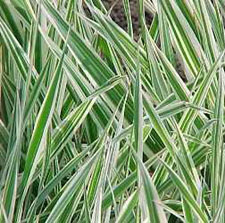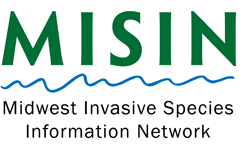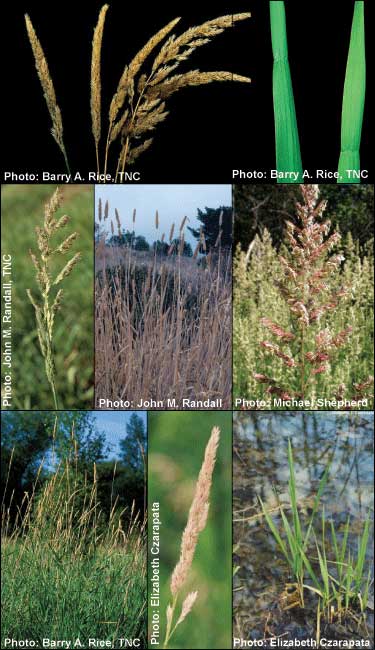|
Reed canarygrass (Phalaris arundinacea)
Introduced as an ornamental garden plant from Europe, often called "ribbon grass."
Why is it a problem? Like most invasive plants, reed canary grass threatens to replace native plants in high quality natural areas, especially wetlands, which in turn reduces critical food resources for birds, butterflies, and other wild creatures. This grass grows both through seed spread and using creeping stems (“rhizomes”), which allows the plant to grow quickly and thickly. When reed canary grass enters an area, its numerous stems can collect debris such as silt (sedimentation). This can dry up a shallow water habitat and make it into a terrestrial area, destroying the habitat for native aquatic animals that have been living there. Furthermore, the dense stands of reed canary grass are very unwelcoming to waterfowl and as a result waterfowl do not frequent areas with purple loosestrife. Reed canary grass is known for its large single-species stands (“monocultures”) and the ability to withstand floods and drought. What does reed canary grass look like? Reed canary grass is a large, coarse grass which grows 2-9 feet tall. Its stem and leaves are bluish-green in color with tapering leaf blades, and has dense clustered flowers that bloom May-mid June. Flowers are green to purple, but fade to beige as seeds ripen. Horticultural cultivars (sometimes called “ribbon grass”) may sport green and white striped leaves. How do I manage reed canary grass? Reed canary grass is known for dense monocultures and is difficult to control. Herbicide application in late summer or early fall provides the most effective control especially for large populations. Cutting of reed canary grass is largely unsuccessful due to the rapid regrowth of the plant. Even methods that include cutting and covering the plant are often unsuccessful, as reed canary grass can grow through many materials. Due to the extreme difficulty of eradicating reed canary grass, it is recommended landowners contact a professional to deal with this plant. However, you can find very thorough treatment instructions using the Midwest Invasive Plant Network (MIPN) control database (http://mipncontroldatabase.wisc.edu/). |
|
| habitatmatters.org |
Contact US231-252-4148
3334 Veterans Drive Unit A Traverse City, Michigan 49685 |
Pleasant Peninsula Design, Habitat Matters 2017




